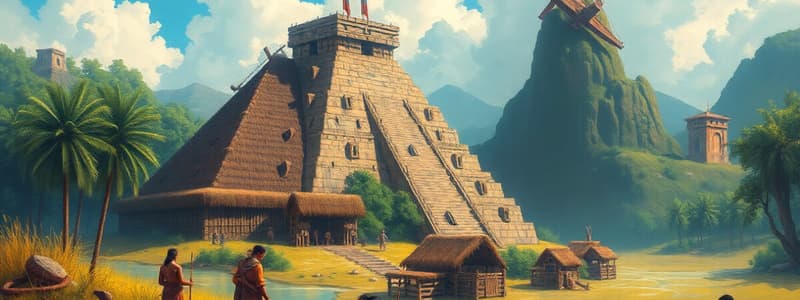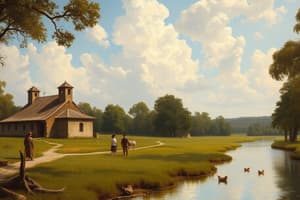Podcast
Questions and Answers
What was the capital city of the Mississippian culture, known for being the largest city north of Mexico before Columbus?
What was the capital city of the Mississippian culture, known for being the largest city north of Mexico before Columbus?
- Chichen Itza
- Teotihuacan
- Mesa Verde
- Cahokia (correct)
What feature ensured the security of the Mississippian city of Cahokia?
What feature ensured the security of the Mississippian city of Cahokia?
- Complex trade networks
- Strategic location near water
- Construction of massive mounds
- Walled structures (correct)
How did the Iroquois Confederacy structure their society?
How did the Iroquois Confederacy structure their society?
- Men led villages, women were warriors
- Council of elders made all decisions
- Male lineage determined leadership roles
- Women held leadership roles in villages (correct)
What system of governance characterized the Mayan civilization?
What system of governance characterized the Mayan civilization?
Which of the following was a significant architectural feature of the Teotihuacan civilization?
Which of the following was a significant architectural feature of the Teotihuacan civilization?
What innovation is NOT associated with the Mayan civilization?
What innovation is NOT associated with the Mayan civilization?
Which civilization is known for building large structures on the sides of cliffs?
Which civilization is known for building large structures on the sides of cliffs?
Which of the following statements best describes the religious practices of the Mayans?
Which of the following statements best describes the religious practices of the Mayans?
What led to the downfall of many Mayan city-states?
What led to the downfall of many Mayan city-states?
What describes the societal structure of the Mississippian culture?
What describes the societal structure of the Mississippian culture?
What was a significant feature of Tenochtitlan that contributed to its defense?
What was a significant feature of Tenochtitlan that contributed to its defense?
What economic system did the Inca implement to ensure labor from conquered peoples?
What economic system did the Inca implement to ensure labor from conquered peoples?
How did the social structure of the Aztec society categorize their rulers?
How did the social structure of the Aztec society categorize their rulers?
What was the primary agricultural method used by the Mexica to grow crops in Lake Texcoco?
What was the primary agricultural method used by the Mexica to grow crops in Lake Texcoco?
In what way did the Toltecs influence later cultures such as the Aztecs?
In what way did the Toltecs influence later cultures such as the Aztecs?
What was the primary reason the Mexica migrated to the south?
What was the primary reason the Mexica migrated to the south?
Which statement describes the political structure of the Incas?
Which statement describes the political structure of the Incas?
Which of the following best describes the role of women in Mesoamerican cultures?
Which of the following best describes the role of women in Mesoamerican cultures?
What was a common practice in the religions of the Inca, as well as other Mesoamerican societies?
What was a common practice in the religions of the Inca, as well as other Mesoamerican societies?
How did the social structure of the Inca Empire categorize common people?
How did the social structure of the Inca Empire categorize common people?
Flashcards
Mississippian Culture
Mississippian Culture
A powerful civilization that thrived in North America from 700 CE to 1450 CE, known for their impressive mound-building and extensive trade network.
Cahokia
Cahokia
The largest city north of Mexico before Columbus, serving as the capital of the Mississippian civilization and known for its impressive size and complex social structure.
Mound Builders
Mound Builders
The Mississippian people were known for their construction of large earthen mounds, which served as platforms for important structures and dwellings.
Woodhenge
Woodhenge
Signup and view all the flashcards
Matrilineal Society
Matrilineal Society
Signup and view all the flashcards
Southwest Civilizations
Southwest Civilizations
Signup and view all the flashcards
Navajo Irrigation System
Navajo Irrigation System
Signup and view all the flashcards
Mesa Verde
Mesa Verde
Signup and view all the flashcards
Iroquois Confederacy
Iroquois Confederacy
Signup and view all the flashcards
Mayan Civilization
Mayan Civilization
Signup and view all the flashcards
Toltec Culture
Toltec Culture
Signup and view all the flashcards
Aztec Origins
Aztec Origins
Signup and view all the flashcards
Chinampas
Chinampas
Signup and view all the flashcards
Aztec Triple Alliance
Aztec Triple Alliance
Signup and view all the flashcards
Aztec Tribute System
Aztec Tribute System
Signup and view all the flashcards
Inca Origins
Inca Origins
Signup and view all the flashcards
Inca Empire Structure
Inca Empire Structure
Signup and view all the flashcards
Mita System
Mita System
Signup and view all the flashcards
Inca Social Structure
Inca Social Structure
Signup and view all the flashcards
Gender Parallelism in Mesoamerica
Gender Parallelism in Mesoamerica
Signup and view all the flashcards
Study Notes
North American Political Traditions
-
Mississippian Culture (700 CE - 1450 CE): A large trading empire centered on Cahokia, the largest pre-Columbian city north of Mexico. Known for large earthen mounds (burial sites). Practiced human sacrifice. Developed a sophisticated astronomical observatory ("Woodhenge"). Had a matrilineal society, tracing descent through women.
-
Southwest Civilizations: Adapted to arid conditions in the southwest US, developing irrigation systems for agriculture. Examples include the Navajo, who built irrigation systems, and the Mesa Verde people, who constructed dwellings into cliff sides.
-
Iroquois Confederacy: An alliance of five tribes (Mohawk, Oneida, Onondaga, Cayuga, Seneca) in the northeast US. A matrilineal society with women in charge of villages and men responsible for warfare and hunting.
Mesoamerican Political Traditions
-
Mayan Civilization (250 BCE - 900 CE): A civilization of city-states across the Yucatán Peninsula. Known for innovations like the concept of zero and a complex writing system. Developed an accurate calendar and built massive pyramids for astronomical observations. Polytheistic, with important gods of sun, rain, and corn and human sacrifice.
-
Teotihuacan (100 CE - 750 CE): A massive city that profoundly influenced Mesoamerica. Had a large temple complex, including the Avenue of the Dead and one of the largest pyramids. The cause of its disappearance is uncertain, with theories ranging from conquest to internal revolt.
-
Toltec Civilization (900 CE - 1168 CE): A military culture that dominated the Valley of Mexico. Considered a "mother culture" for Mesoamerica, influencing subsequent civilizations including the Aztecs. Known for large stone temples and the cult of Quetzalcoatl. Practiced human sacrifice.
-
Mexica/Aztec Empire: The Mexica, seeking a new homeland after a period of migration due to drought, settled on an island in Lake Texcoco in 1325, establishing Tenochtitlan. Built causeways for defense and access. Developed chinampas (floating gardens). The Aztec Triple Alliance, a union of the Mexica, Texcoco, and Tlacopan, conquered surrounding civilizations to expand their empire, demanding tribute as well as expanding their religious beliefs and influence. They lacked a bureaucracy and kept local governments intact.
South American Political Traditions
-
Chimu Empire (900 CE - 1470 CE): Controlled the lowlands, known for advanced agricultural techniques, irrigation, and extensive agriculture.
-
Lupaca Empire (1150 CE - 1463 CE): Controlled the highlands, using stone retaining walls to build terraced fields.
-
Inca Empire: Migrated to the Andean highlands, establishing a large empire stretching 2,500 miles along the Andes, creating provinces, and demanding tribute labor (mita system). Conquered areas were forced to learn Quechua and assimilate Inca culture, and used hostages. Roads connected the empire, which was a key to its cohesion.
Social and Cultural Traditions
-
Social Structures: Emperors were semi-divine in most empires. Priests held influence. Warriors, nobles, artisans, merchants, farmers, and slaves formed the different social classes. Different social classes throughout both the Mesoamerica and South America civilizations.
-
Political Structures: These civilizations utilized different governments styles from Empires, to civilizations of city states, and others with alliances amongst tribes. Variations in structure and governmental styles and ruling bodies.
-
Religions: Polytheistic and animistic religions were common, with varying gods and importance placed on human sacrifice in religious practices across the cultures and civilizations.
Gender Roles
-
Gender Parallelism: A societal structure that allowed for complementary roles where men and women worked in different spheres seen in MesoAmerica and South America cultures.
-
Examples of roles: Some women held positions as priests, merchants, or midwives, while men and women held roles in farming, tribute, and leadership.
Studying That Suits You
Use AI to generate personalized quizzes and flashcards to suit your learning preferences.




